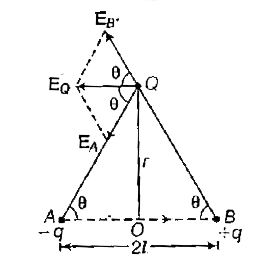Define electric filed and electric potential at a point . Derive the expression for the electric field due to an electric dipole at an equatorial point.
Electric Field The region surrounding a charge or distribution of charge in which its electrical effects can be observed or experienced is called the electric field of the charge or distribution of charge. Electrostatic Potential The electric potential at any point in the region of electric field is defined as the amount of work done in bringing a unit positive test charge (without acceleration) from infinity to that point along any arbitrary. path.
Electrostatic potential (V) = Work done (w) / Charge (q0)
Electric field intensity due to an electric dipole at an equatorial point Consider an electric dipole consisting of two point charges + q and -q separated by a small distance AB = 2l with centre at O and dipole moment, p= q(2l) as . shown in the figure:

Resultant electric field intensity at the point,Q,
EQ=EA+EB
The vectors EA and EB are acting at an angle 2θ.
Here, EA=14πε0q(r2+l2)
EB=14πε0q(r2+l2)
On resolving EA and EB into two rectangular components, the vectors EAsinθ and EBsinθ are equal in magnitude and . opposite to each other and hence cancel out. The vectors EAcosθ and EBcosθ are acting along the same direction and hence add up.
∴EQ=EAcosθ+EBcosθ
=2EAcosθ
=24πε0q(r2+l2).l(r2+l2)1/2(∵cosθ=l(r2+l2)1/2)
=14πε0.2ql(r2+l2)3/2
But q x 2l = |p| , the dipole moment,
EQ=14πε0.|p|(r2+l2)3/2
The direction of EQ is along QE || BA, i.e. opposite to AB. In vector form, we can rewrite as
EQ=−p4πε0(r2+l2)3/2
Obviously, EQ is in a direction opposite to the direction of p. If the dipole is short, i.e. 2l << r, then
EQ=14πε0.|p|r3
Similar Questions
Knowledge Check
The electrostatic potnetial due to an electric dipole at an equatorial point is
AmaximumBzeroCminimumDnot definedThe electric potential at a point on the equatorial line of a electric dipole is
Adirectly proportional to the square of the distanceBindirectly proportional to the square of the distanceCdirectly proportional to the chargeDnone of the above
(a) Define electric dipole moment. Is it a scalar or a vector ? Derive the expression for the electric field of a dipole at a point on the equatorial plane of the dipole.
(b) Draw the equipotential surfaces due to an electric dipole. Locate the points where the potential due to the dipole is zero.
View SolutionDerive the expression for the electric potential at any point along the axial line of an electric dipole.
View SolutionWhat is an electric dipole and electric dipole moment? Derive an expression for electric potential at any point due to an electric dipole. Also discuss the special cases.
View SolutionDeive an expression for the electric field at any point on the equatorial line of an electric dipole.
View SolutionWhat is the electric potential at a point on the equatorial plane of a short electric dipole?
View SolutionElectric Field Intensity Due To An Electric Dipole At A Point On The Equatorial Line
View Solution
